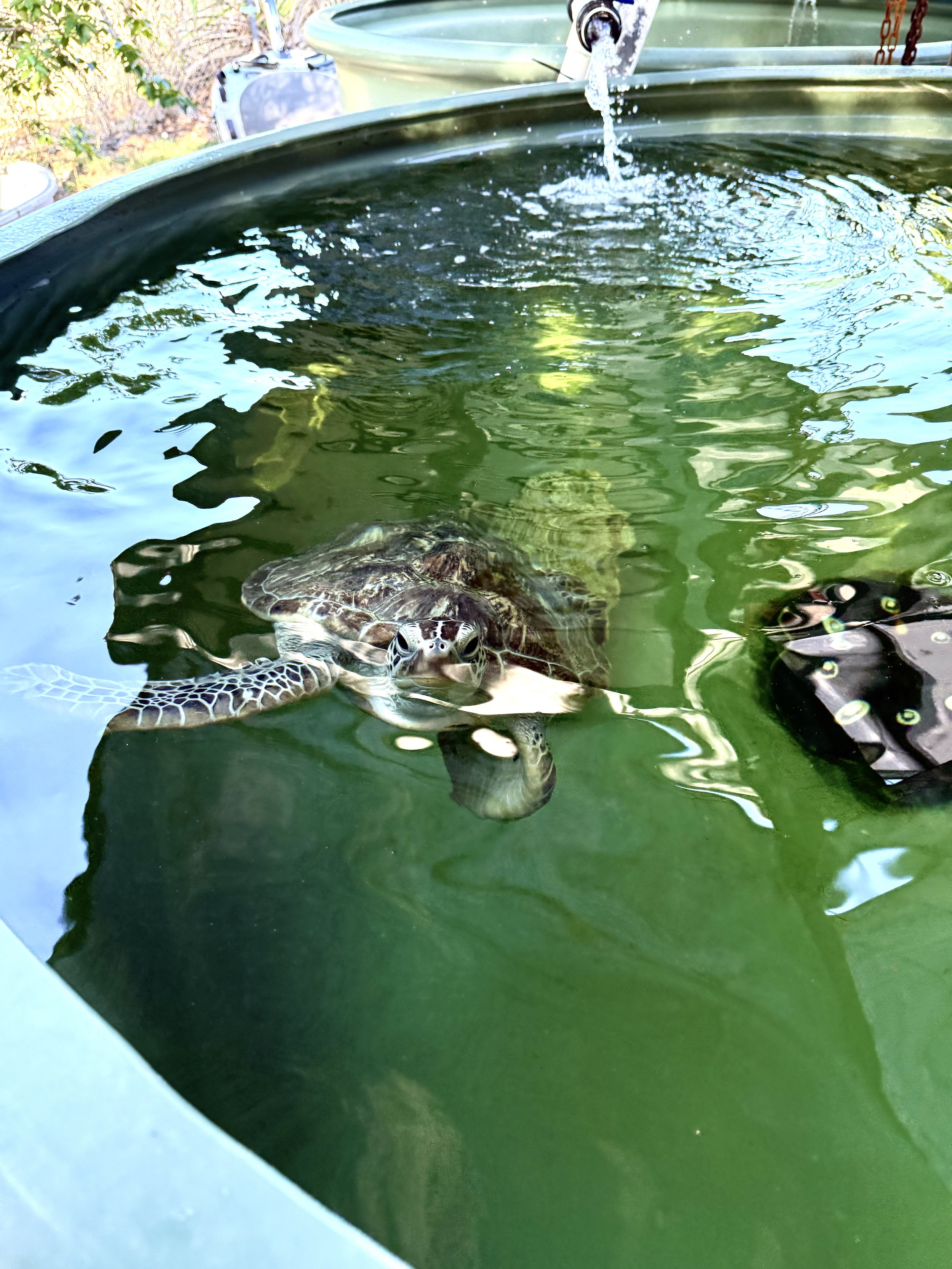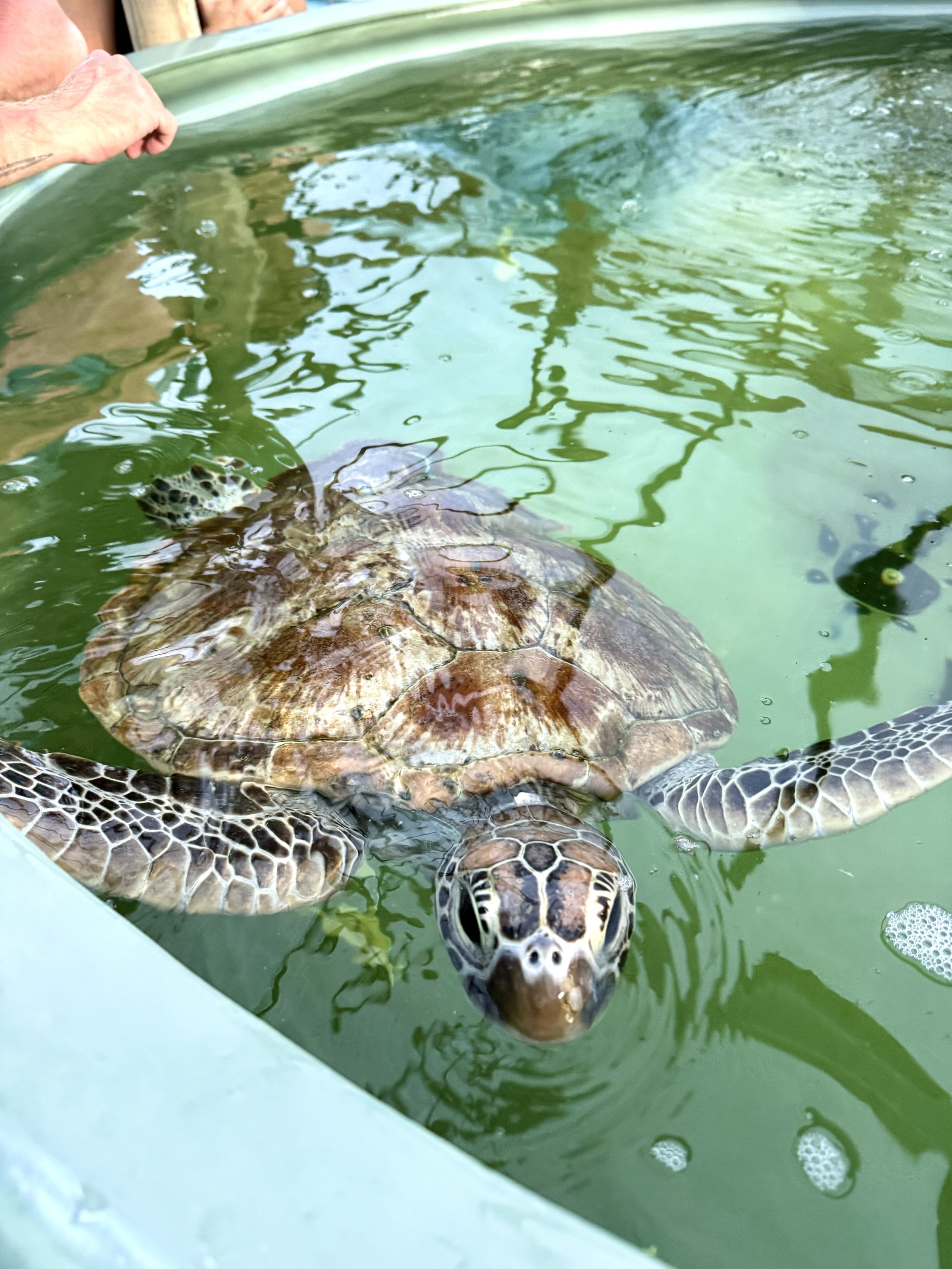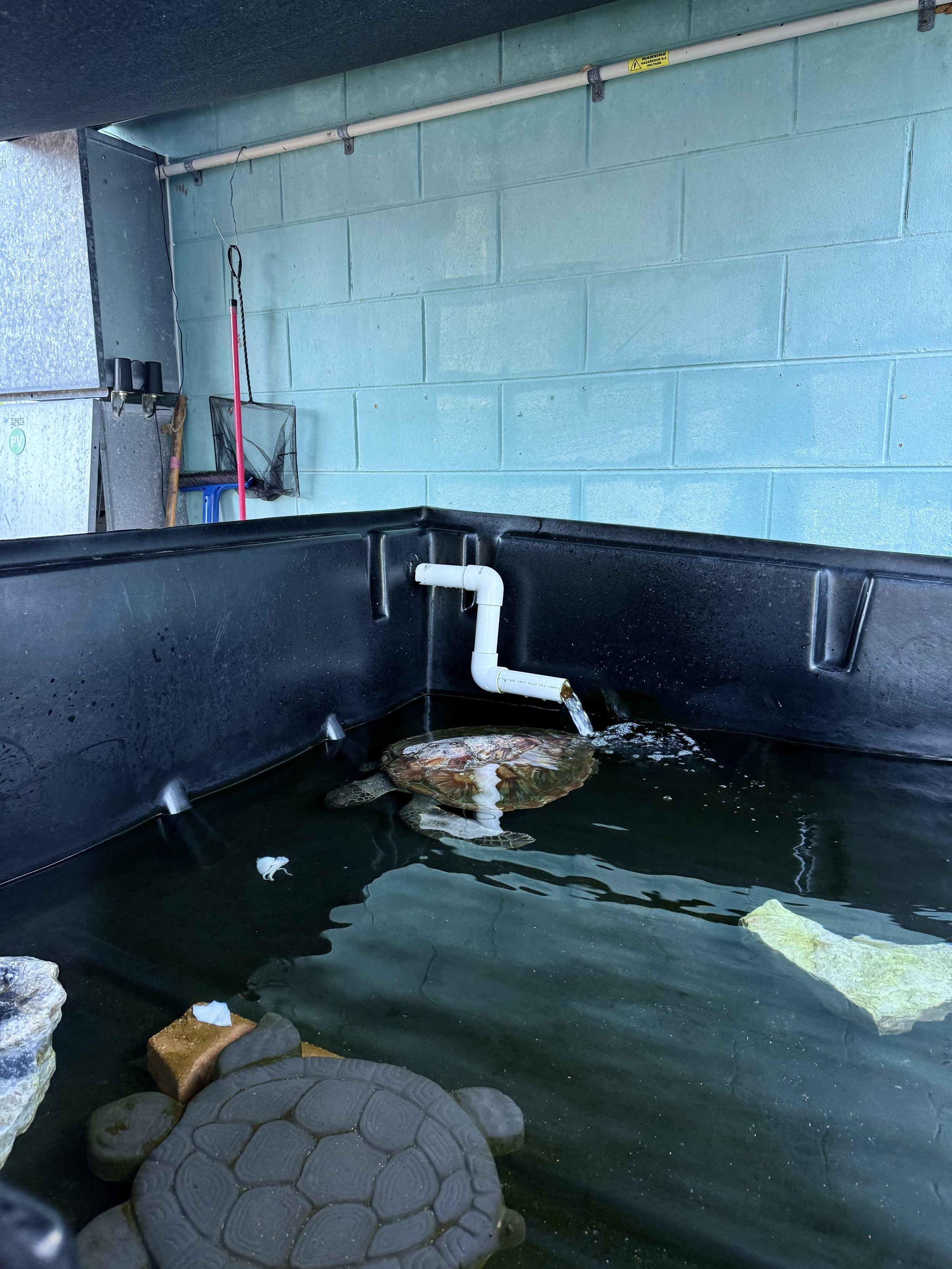
Turtle Tales: An Afternoon with MINT’s Marine Patients
Our visit to the Magnetic Island Network for Turtles (MINT) allowed us to meet five turtles, each at a different stage of their recovery journey. Some had recently arrived, while others were nearly ready for release back into the wild. We learned that rescuers often name the turtles they care for, and of the five we met, only one had its sex confirmed. Why? Turtles can typically only be sexed by their tails once they reach 10–15 years old. Male turtles develop tails that extend well beyond their shells, growing up to 30 cm long!
Meet the Turtles
FIREBALL
First, we met Fireball, a turtle in Stage 1 care in one of MINT’s ICU tanks. She was found beached and underweight four weeks ago, showing symptoms of SSS. Fireball is receiving fluids and appetite stimulants to help her recover, but her shell remains soft around the edges.
LOLA
Next was Lola, another Green Turtle housed in the ICU. She arrived just three days before our visit, underweight and floating. The team is treating her for internal and external parasites, improving her diving ability, and helping her gain at least 1 kg.
TAMMY
Tammy, the biggest turtle in care, weighs an impressive 62.5 kg! Found floating and abnormally weak near Townsville in early November, Tammy reached an important milestone the day of our visit - eating for the first time since her admission.
NORMAN
Norman (pictured above), is a juvenile Green Turtle, was rescued in poor condition in early September. Covered in barnacles and algae, he had severe scute shedding, gas in his body cavity, infections, and a high parasite load. Now in Stage 3 care, Norman has made incredible progress, gaining weight from 8 kg to 12 kg. In his pre-release phase, carers are reducing interaction to prepare him for life in the wild. He was very inquisitive, likely because he thought I was going to feed him!
CASPER
We spent the most time learning about Casper, who was recaptured by JCU researchers near Townsville. Underweight and covered in barnacles, Casper’s recovery goals include gaining 2 kg, eliminating parasites, and healing his carapace. We even got to help during feeding time! Casper, weighing just over 11 kg, eats roughly 1 kg of seafood daily. Leanne explained that Casper’s calm demeanour around people might allow for a public release - stay tuned!








Nesting season on Magnetic Island
Nesting season runs from November to March, with hatchlings typically emerging in January. Flatback Turtles (Natator depressus) favour the southern beaches of the island, while Green Turtles (Chelonia mydas) are more commonly seen on the northern shores. So far this season, 10 Flatback nests have been recorded - a hopeful sign for our local turtle populations. This year, MINT is trialing the use of palm fronds to cool nests. Rising sand temperatures have drastically reduced hatchling survival rates. Heat-related mortality dropped hatchling success to 60% during the 2019–2020 season compared to 90% between 2008–2013. These trials aim to improve survival odds for our local turtles.
Flatback Turtles (Natator Depressus)
Nest every 2–3 years, laying 2–3 clutches per season.
Lay the fewest eggs among marine turtles, averaging 50 eggs per nest.
Incubation lasts 45–55 days.
Have the largest eggs and hatchlings relative to their body size.
Green Turtles (Chelonia Mydas)
Nest every 2 years, laying up to 5 clutches per season, typically 2 weeks apart.
Average 115 eggs per nest.
Incubation lasts 42–69 days.
The eggs are round, roughly the size of ping-pong balls.
Fascinating Turtle Facts
Life Cycle and Reproduction
Turtles reach sexual maturity at 15–20 years, with most nesting after age 25.
Female sea turtles typically return to the same beach where they were born to nest each year.
Gender is determined by sand temperature during incubation: warmer sand produces more females, cooler sand produces more males.
Turtle Anatomy
A turtle’s carapace, or shell, acts as its armour, made from keratin - the same material as human hair and nails. Most sea turtles’ spines and ribs are fused to their carapace.
Leatherback Turtles, however, have unique anatomy. Their spines are not fused to a bony shell but are supported by leathery skin and a mosaic of tiny bones. Rare sightings of these giants around Magnetic Island are unforgettable, with lengths of 1.2–2.4 metres and weights of 360–450 kg!
What do they eat
Green Turtles: Adults are herbivores, primarily feeding on algae, seagrasses, and seaweed, while hatchlings are omnivores. Their serrated beak is perfect for scraping algae and tearing vegetation.
Flatback Turtle: Omnivores with a diverse diet, including sea cucumbers, jellies, corals, shrimp, crabs, molluscs, fish, and seaweed.
Changing environments and the decline of seagrass beds are forcing turtles to adapt. While in care, they consume seafood, as laws protecting the National and Marine Parks prohibit collecting seaweed, even washed-up pieces, for the turtles. These turtles eat around 10% of their body weight daily, that’s about 1kg for a turtle like Casper! The MINT team estimates that feeding each turtle costs an average of $25 per day.
This is why raising awareness and funds through initiatives like our Containers for Change program is so vital for their care. And believe it or not, turtles have individual preferences, just like us, imagine saying no to a Moreton Bay bug!
How you can help
Protecting turtles during nesting season requires community effort. Here’s how you can contribute:
Avoid nesting sites to minimise disturbance.
Report sea turtle nesting activity to MINT.
Keep dogs on leashes near nesting areas.
Go slow for those below - watch for turtles while boating.
Join beach clean-ups to reduce hazards for turtles.
Donate to support turtle conservation efforts.
Support businesses who act in a way that’s positive to the environment and its marine wildlife.
Volunteer your time to assist with conservation projects.
Protect seagrass beds by avoiding damage from boating or anchoring.
Dispose of fishing gear responsibly.
When observing hatchlings, always use a red light, as white lights can disorientate them and lead them away from the water.
Here’s how we help
At Magnetic Island Jet Skis, we recognise our responsibility in protecting Magnetic Island’s National and Marine Parks and the unique wildlife within them. Here’s how we contribute to safeguarding the island’s turtles:
Jet Ski Design: Unlike boats, jet skis have no underwater running gear like propellers or rudders, which are a leading cause of turtle injuries and fatalities. This design greatly reduces the risk of harming marine life.
Low Impact Practices: Jet skis produce minimal wash and wake, and we limit their speed to 4 knots in green zones and when close to shore to protect sensitive habitats.
Anchor-Free Zones: We only anchor in Horseshoe Bay, on the sand, this means we don’t drop anchors in green zones or on seagrass beds to protect these vital ecosystems.
Recycling Initiatives: Through the Containers for Change program, we raise funds to support MINT.
Community Efforts: We volunteer and raise awareness for local Clean Up Days. Each day we actively remove debris, plastics, and fishing lines from the environment.
Ongoing Education: We continuously improve our knowledge and share it through platforms like This Is Magnetic Island, our welcome guide, and other resources to educate visitors.
By respecting and protecting these incredible creatures, we aim to inspire our guests to join us in safeguarding their future, ensuring turtles can continue to thrive for another 250 million years!